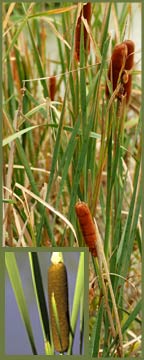Narrow-leaved and Hybrid Cattail
 Typha angustifolia and Typha x glauca
Typha angustifolia and Typha x glauca
Narrow-leaved Cattail is considered an invasive species and is believed to be introduced to North America. It forms a hybrid with common Cattail which can dominate wetland environments.
Description - Cattail
General: Cattails are perennial aquatic plants that can grow up to 3 meters in height.
Leaves: leaves are slightly convex on the back, 5-12 mm wide for narrow-leaved cattails and may be wider 6-15 mm for hybrid cattails.
Stem: Arising from thick creeping rhizomes, the flowering stalk is light green - green, stiff, round in cross-section and up to 3 meters tall.
Flowers: For narrow-leaved cattails male and female flowers are grouped into two spikes along the same stalk. Male flowers with pollen are in the top spike separated usually by 10 - 75 mm from the female flowers in the bottom spike. This length between spikes is generally less for hybrid cattails.
Seeds/Fruit: Soft, downy seeds clustered in "Cattail" shape.
Habitat
Generally found in wetlands, sedge meadows, streams, river banks, ditches, and lake shores.
Dispersal
Spreads to new areas by seeds but once present an extensive rhizome system is the major source of reproduction.
Impacts
Cattails are capable of growing in dense monocultures and forming thick masses of vegetation. Ecological impacts include closing of open water areas, eliminating habitat and species diversity, and reducing and replacing native plants. It can dominate shorelines and wetlands and replace native plants important for Waterfowl and wildlife.
Control Methods
Control methods may include water level modifications, chemical control, physical control (hand or mechanical cutting), and prescribed burning. Manipulation of water levels attempts to kill Cattails by inhibiting airflow from the shoots to the roots. Cutting stems below the water surface in late summer or fall may also be effective. Burning can be used in combination with manipulation of water levels. In order for burning to be successful the roots must also be burned. Chemical control may not be a preferred option in sensitive wetland and aquatic habitats.
Resources
Narrow Leaved and Hybrid Cattail ISCM Fact Sheet
Narrow Leaved and Hybrid Cattail — Project Fact Sheet
Â
Back to Aquatic Invasive Species List
Â

